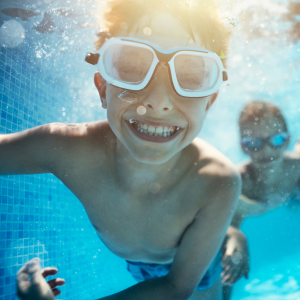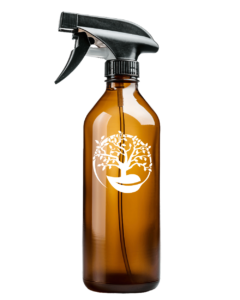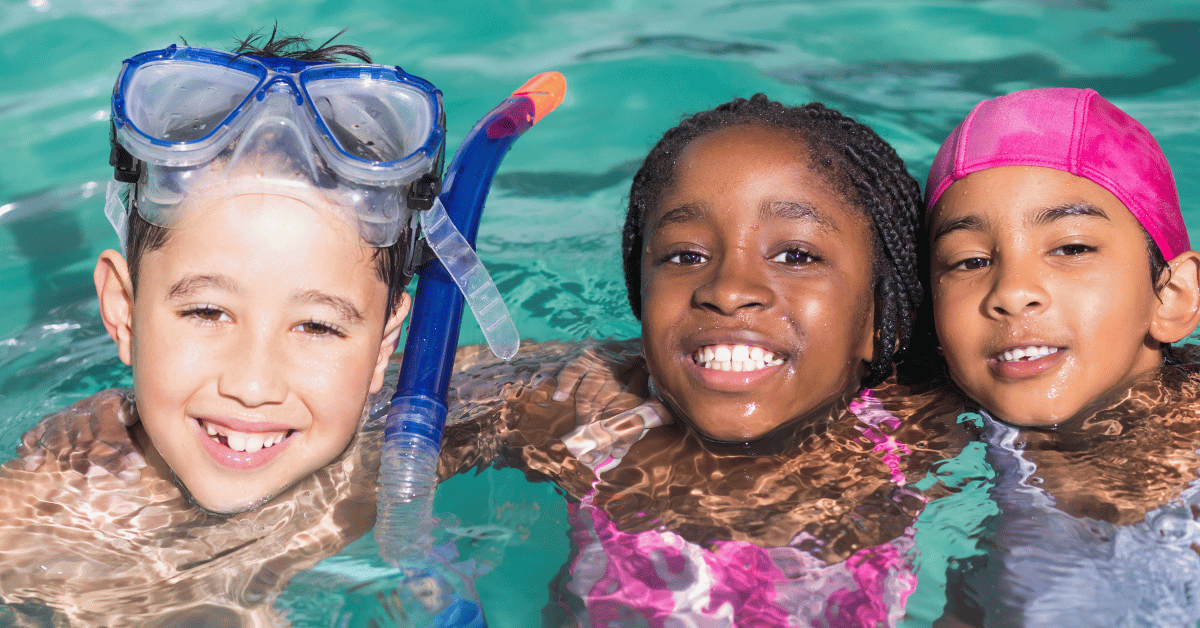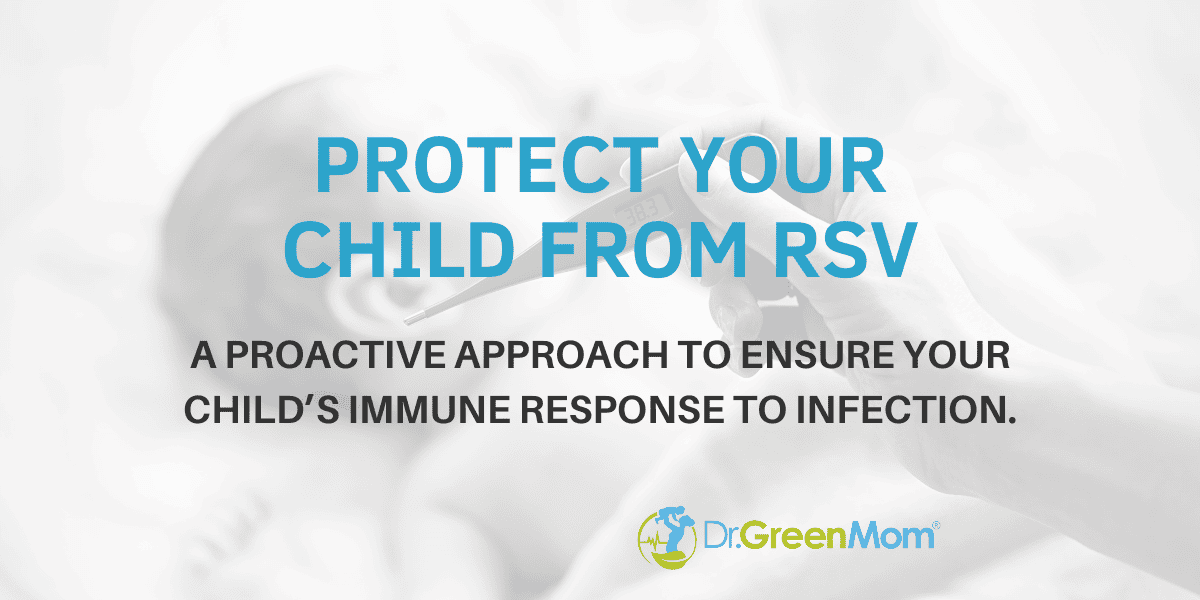Swimming is a favorite summer activity for many families, offering both fun and exercise. I am all about taking a balanced approach to health, and swimming in chlorinated pools is one of those times where the benefits from the enjoyment and active play outweigh the risks of the exposure to chlorine for most families. That said, I still recommend taking a few simple steps to minimize exposure.
This article explains the potential downside of swimming in chlorinated water and it shares tips to minimize problems, including a recipe for a simple DIY chlorine neutralizing skin spray.
The Downside of Swimming in Chlorinated Water
While chlorine is necessary to kill harmful bacteria in pool water, it can be harsh on the skin and lungs while contributing to our overall toxic load (1).
 When it comes to the skin in particular, chlorine strips away natural oils that keep the skin soft and moisturized. In fact, research shows that athletes who train in swimming pools often have changes in their skin barrier when compared to athletes who train outdoors (2). A disrupted skin barrier is associated with the development of atopic dermatitis (3). It is important to moisturize the skin after chlorine exposure, as this is the most effective way to maintain skin barrier function (4).
When it comes to the skin in particular, chlorine strips away natural oils that keep the skin soft and moisturized. In fact, research shows that athletes who train in swimming pools often have changes in their skin barrier when compared to athletes who train outdoors (2). A disrupted skin barrier is associated with the development of atopic dermatitis (3). It is important to moisturize the skin after chlorine exposure, as this is the most effective way to maintain skin barrier function (4).
Chloramines: The Toxic Byproducts of Chlorine
When chlorine reacts with organic matter, such as sweat, urine, and skin cells, it forms compounds known as chloramines (5). Chloramines are not only responsible for the strong chlorine smell, but they are also more irritating than chlorine. Chloramines can cause red, itchy skin; burning eyes; and respiratory issues (6). This is particularly concerning for children with asthma or other respiratory conditions, as inhaling chloramines can exacerbate their symptoms (7).
To learn more about the potential health effects of chlorine, read: The Risks Of Swimming In Chlorinated Pools.
How Vitamin C Neutralizes Chlorine and Chloramines
Vitamin C, or ascorbic acid, is a powerful antioxidant that can neutralize chlorine and chloramines effectively. When applied topically, vitamin C converts chlorine and chloramines on the skin into the harmless compounds dehydroascorbic acid and hydrochloric acid (8,9).
Dehydroascorbic acid is simply the oxidized form of vitamin C. It is naturally present in the body and can be converted back to ascorbic acid (vitamin C) by cellular mechanisms, and the amount of hydrochloric acid (which is an acid that is naturally produced by the body), is so small that it is not irritating to the skin.
 Dr. Green Mom’s DIY Chlorine Neutralizing Vitamin C Skin Spray
Dr. Green Mom’s DIY Chlorine Neutralizing Vitamin C Skin Spray
Here’s how to make your own chlorine neutralizing skin spray at home.
Ingredients:
- 1 cup of distilled water
- 1 teaspoon of ascorbic acid powder (vitamin C)
- 1 amber glass spray bottle* (8 oz recommended)
Directions:
- Dissolve one teaspoon of ascorbic acid powder in one cup of distilled water, and stir well until the powder is completely dissolved.
- Pour solution into a brown glass spray bottle. The brown glass helps protect the solution from light, which can degrade Vitamin C.
*Glass does not mix well with pools, but as vitamin C can degrade plastic, glass is recommended here. Please be very careful! I recommend getting a silicone sleeve for your glass bottle to reduce risk of breakage.
How to Use the DIY Skin Spray
Immediately before swimming:
- Rinse off in the shower. This does two things: It rinses off any sweat that can contribute to chloramines forming and saturates your skin so that when you jump in the pool your skin will absorb less of the chlorinated water as it has previously absorbed water from the shower.
- After rinsing in the shower, pat yourself dry and spray yourself with the vitamin C spray, watching out for the eyes.
- Apply your sunscreen, and optionally seal it all in with a thin layer of a barrier cream, moisturizer, or coconut oil.
After swimming:
- Rinse off with fresh water to remove as much chlorine as possible.
- Spray the vitamin C solution liberally over the skin again. Allow it to sit for a few minutes before patting dry.
- Seal it in and soothe the skin by applying a moisturizing lotion.
This simple routine helps neutralize any remaining chlorine residue, reducing the risk of systemic absorption and irritation. If this sounds like too much, simply rinsing off and using the spray immediately after swimming helps, too!
How to Store the DIY Skin Spray for Efficacy
To maintain the efficacy of your DIY chlorine neutralizing spray, store it in a cool dark place. The brown glass bottle will help protect the vitamin C solution from light, which can degrade its effectiveness. Be sure to shake the bottle well before each use to ensure the solution is properly mixed. The spray should remain effective for up to two weeks if stored correctly.
For more like this, see: DIY After-Sun Spray For Natural Sunburn Relief.
Additional Tips for Protecting Your Family from Chlorine Exposure
Here are some additional tips to help protect your family from chlorine exposure. It is important to note that none of these offer 100% protection, but my recommendation is to do what you can, and then focus on enjoying the experience rather than worrying about residual chlorine exposure.
- Always Shower Before and After Swimming: Encourage your children to shower before entering the pool. This helps reduce the amount of organic material on their skin that can react with chlorine and reduces chlorine absorption by the skin. Showering after swimming washes away chlorine from their skin and hair.
- Use a Barrier Cream or Lotion: Applying a barrier cream before swimming can provide an extra layer of protection. I recommend applying a thin layer of your favorite moisturizer or even some coconut oil over your sunscreen of choice.
- Take Vitamin C Internally: Increasing your vitamin C intake on days your family visits the pool can be a great way to support chlorine detoxification from the inside out!
- Choose Natural Bodies of Water When Possible: When conditions allow, opt for swimming in lakes or the ocean, which do not contain chlorine and are often gentler on the skin.
- Wear Goggles: Protect your children’s eyes from the irritating effects of chlorine and chloramines by ensuring they wear swimming goggles.
Summary
Swimming is a wonderful activity for families, but chlorine exposure is a definite downside. By showering before and after chlorine exposure, using a vitamin C skin spray with a moisturizing lotion, and increasing vitamin C intake, you can minimize the risks while enjoying your summer to the fullest.
References:
- Li, J. H., Wang, Z. H., Zhu, X. J., Deng, Z. H., Cai, C. X., Qiu, L. Q., Chen, W., & Lin, Y. J. (2015). Health effects from swimming training in chlorinated pools and the corresponding metabolic stress pathways. PloS one, 10(3), e0119241. https://doi.org/10.1371/journal.pone.0119241
- Paciência, I., Rodolfo, A., Leão, L., Silva, D., Cavaleiro Rufo, J., Mendes, F., Padrão, P., Moreira, P., Laerte Boechat, J., Delgado, L., & Moreira, A. (2021). Effects of Exercise on the Skin Epithelial Barrier of Young Elite Athletes-Swimming Comparatively to Non-Water Sports Training Session. International journal of environmental research and public health, 18(2), 653. https://doi.org/10.3390/ijerph18020653
- Kim, B. E., & Leung, D. Y. M. (2018). Significance of Skin Barrier Dysfunction in Atopic Dermatitis. Allergy, asthma & immunology research, 10(3), 207–215. https://doi.org/10.4168/aair.2018.10.3.207
- Rajkumar, J., Chandan, N., Lio, P., & Shi, V. (2023). The Skin Barrier and Moisturization: Function, Disruption, and Mechanisms of Repair. Skin pharmacology and physiology, 36(4), 174–185. https://doi.org/10.1159/000534136
- Yadav, A. K., Bracher, A., Doran, S. F., Leustik, M., Squadrito, G. L., Postlethwait, E. M., & Matalon, S. (2010). Mechanisms and modification of chlorine-induced lung injury in animals. Proceedings of the American Thoracic Society, 7(4), 278–283. https://doi.org/10.1513/pats.201001-009SM
- Swinarew, A. S., Stanula, A. J., Gabor, J., Raif, P., Paluch, J., Karpiński, J., Kubik, K., Okła, H., Ostrowski, A., Tkacz, E., Skoczyński, S., Waśkiewicz, Z., Rosemann, T., Nikolaidis, P. T., & Knechtle, B. (2020). The influence of chlorine in indoor swimming pools on the composition of breathing phase of professional swimmers. Respiratory research, 21(1), 88. https://doi.org/10.1186/s12931-020-01350-y
- Weisel, C. P., Richardson, S. D., Nemery, B., Aggazzotti, G., Baraldi, E., Blatchley, E. R., 3rd, Blount, B. C., Carlsen, K. H., Eggleston, P. A., Frimmel, F. H., Goodman, M., Gordon, G., Grinshpun, S. A., Heederik, D., Kogevinas, M., LaKind, J. S., Nieuwenhuijsen, M. J., Piper, F. C., & Sattar, S. A. (2009). Childhood asthma and environmental exposures at swimming pools: state of the science and research recommendations. Environmental health perspectives, 117(4), 500–507. https://doi.org/10.1289/ehp.11513
- USDA. Using Vitamin C to Neutralize Chlorine in Water Systems. (n.d.). Www.fs.usda.gov. https://www.fs.usda.gov/t-d/pubs/html/05231301/05231301.html
- Yadav, A. K., Bracher, A., Doran, S. F., Leustik, M., Squadrito, G. L., Postlethwait, E. M., & Matalon, S. (2010). Mechanisms and modification of chlorine-induced lung injury in animals. Proceedings of the American Thoracic Society, 7(4), 278–283. https://doi.org/10.1513/pats.201001-009SM







